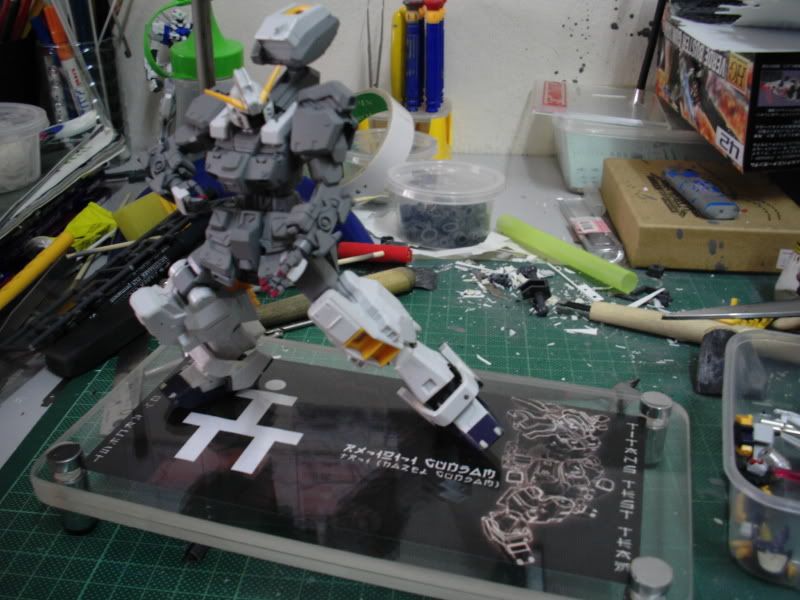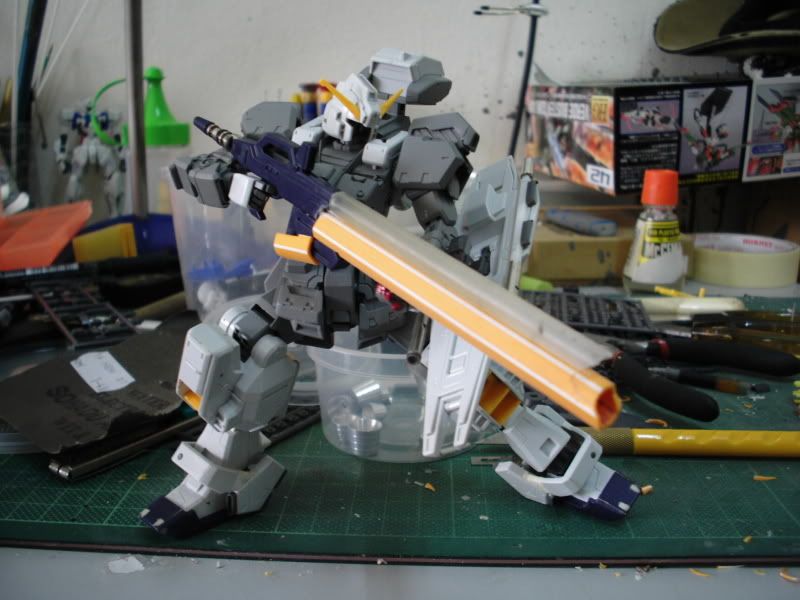LATEST PROGRESS AND FINAL WORK
(please click to view full image)



 Make the panel line
Make the panel line Now posing with the based that i made my self using perspek
Now posing with the based that i made my self using perspek After finish mod the model, i start moding the gun by using pen casing
After finish mod the model, i start moding the gun by using pen casing(please click to view full image)



 Make the panel line
Make the panel line Now posing with the based that i made my self using perspek
Now posing with the based that i made my self using perspek After finish mod the model, i start moding the gun by using pen casing
After finish mod the model, i start moding the gun by using pen casing.JPG)
.JPG)
.JPG)
.JPG)
.JPG)
.JPG)
.JPG)
.JPG)


.JPG)

.JPG)

.JPG)


General and Technical Data
Model number: RX-121-1
Code name: Gundam TR-1 [Hazel Custom]
Unit type: prototype mobile suit
Manufacturer: Earth Federation Forces (Konpeitoh Arsenal)
Operator: Titans Test Team (Black Otter Team)
First deployment: October UC 0085
Accommodation: pilot only, in panoramic monitor/linear seat cockpit in torso
Dimensions: overall height 18.1 meters
Weight: empty 41.5 metric tons; max gross 63.0 metric tons
Armor materials: unknown
Powerplant: Minovsky type ultracompact fusion reactor, output rated at 1420 kW (+390 kW)
Propulsion: rocket thrusters: 18000 kg, 2 x 27000 kg, 2 x 17500 kg, 4 x 1870 kg
Performance: unknown
Equipment and design features: sensors, range 10200 meters; movable booster pod
Fixed armaments: beam saber, mounted on backpack storage rack, hand-carried in use; shield booster, mounted on left arm
Optional fixed armaments: multipurpose weapon latch
Optional hand armaments: XBR-M84a beam rifle, power rating unknown
MODIFY THE
1/144 HAZEL CUSTOM
Here my new gundam modeling project...(maybe for this coming BAKUC in November)..and it is still underconstruction..hehe..I really like this model because of it's compact body form and look tough to me
.JPG)
.JPG)
.JPG)
.JPG)
Also using the plaplate to cover the back of the skirt
.JPG)
.JPG)
After finish with the skirt part i do the sheild and don't know if this ok or not, still need to do something with it.
.JPG)
.JPG)

.JPG)
.JPG)


.JPG)
.JPG)
.JPG)
.JPG)



The original Mobile Suit Gundam was an animated science-fiction series which debuted on Japanese television in 1979. In this groundbreaking series, the traditional giant robots of Japanese anime were for the first time portrayed as realistic war machines instead of invincible superheroes. The people who used these machines to fight in a futuristic space war were complex characters whose motivations and beliefs didn't break down into simple good and evil, and the story encompassed human drama and social commentary as well as thrilling robot battles. Mobile Suit Gundam's popularity led to a series of sequels and followups - first a three-part movie compilation, then a succession of new television serials, original videos, and theatrical films. After more than two decades, this Gundam saga has expanded to include nine television series, four video series, ten movies, and countless novels, comics, and original video game adventures. This saga encompasses six different worlds, each with its own unique history and society, and showcases the work of the most celebrated talents of the anime industry. Although this saga's stories encompass centuries of future history and span several alternate worlds, they all share a single unifying element - the legendary line of fighting machines which bear the name of Gundam. From the prototype RX-78 Gundam featured in the original series, to the unique and colorful machines which star in later stories like G Gundam and Gundam Wing, all these stories recount the adventures of heroic Gundams and their brave pilots. The Gundam saga made its North American debut in 1998, and in the following years Bandai Entertainment has continued to release new chapters of this epic saga. Meanwhile, Bandai America has produced a wide range of merchandise for Gundam fans young and old, including fully poseable action figures and a selection of the astonishing model kits for which Gundam is justly famous. As you explore this Web site, we hope you'll enjoy learning about this fascinating and ever-evolving saga. The name Gundam also applies to the mobile suit RX-78 Gundam, the humanoid fighting vehicle which starred in the original TV series. This heroic giant robot, with its distinctive blue-and-white color scheme and V-shaped antennas, has been reincarnated in almost every one of the Gundam saga's sequels and spinoffs. Often, the title of a Gundam story and the name of the featured Gundam mobile suit are similar or identical, which makes it a little easier to recall which mobile suit stars in which story. The first few Gundam sequels were all written and directed by Tomino, but in the saga's second decade, Sunrise began inviting other creators to contribute their artistic visions to the Gundam saga. Among the Japanese animation legends who've contributed to the Gundam ethos are top directors like Yasuhiro Imagawa (Giant Robo), Masashi Ikeda (Ronin Warriors), and Takeyuki Kanda (Round Vernian Vifam); writers Ryosuke Takahashi (Armored Trooper Votoms) and Hiroyuki Yamaga (Wings of Honneamise); and character designers such as Haruhiko Mikimoto (Macross), Toshihiro Kawamoto (Cowboy Bebop), Shuko Murase (Gasaraki), and Capcom's Akira Yasuda. The roster of Gundam mechanical designers reads like a virtual who's who of the industry. Past and present mobile suit creators include Shoji Kawamori (Macross, Vision of Escaflowne), Hajime Katoki (Virtual On), Kimitoshi Yamane (Vision of Escaflowne, Cowboy Bebop), Yutaka Izubuchi (Mobile Police Patlabor), Makoto Kobayashi (Giant Robo), Mika Akitaka (Martian Successor Nadesico), Mamoru Nagano (Five Star Stories), and even Syd Mead (Blade Runner, Aliens). Is there more than one Gundam world? At present, six Gundam worlds have been featured in the animated stories, which we can classify according to the calendar systems they use. In addition to the original Universal Century, we have G Gundam's Future Century and the After Colony setting used in Gundam Wing and Endless Waltz. Gundam X uses the After War calendar, while Gundam Seed, the latest Gundam show, introduces a new world based on the Cosmic Era calendars. The sixth of these worlds is the distant future of Turn A Gundam, a recent sequel which complicates the picture by suggesting that all these Gundam worlds are just different eras in a future history which spans thousands of years. But for all practical purposes, we can regard these worlds as parallel universes, whose inhabitants know nothing of the events of the other stories - which means the viewer doesn't have to know anything about them either. This term, a loose translation of the Japanese word "gaiden," refers to apocrypha, tie-ins, spin-offs, and unofficial stories - basically, anything that hasn't been animated. Some may have received more official recognition, but none are canonical in the sense that the animated features are. Such tales span a variety of formats, including video games, comics, novels, illustrated "photo-novels," and even theme-park rides!![]() The original Mobile Suit Gundam was an animated science-fiction series which debuted on Japanese television in 1979. Its popularity led to a series of sequels, including nine television series, four video series, ten movies, and countless novels, comics, and original video game adventures which together comprise the epic Gundam saga. Among Japanese fans, the original TV series and its three-part movie adaptation are now fondly referred to as "First Gundam."
The original Mobile Suit Gundam was an animated science-fiction series which debuted on Japanese television in 1979. Its popularity led to a series of sequels, including nine television series, four video series, ten movies, and countless novels, comics, and original video game adventures which together comprise the epic Gundam saga. Among Japanese fans, the original TV series and its three-part movie adaptation are now fondly referred to as "First Gundam."![]()
![]() Yes. At first, every sequel to the original Mobile Suit Gundam story took place in the same setting, a futuristic space age called the Universal Century. However, with the release of Mobile Fighter G Gundam in 1994, the creators began introducing new worlds - parallel universes, one might say - with their own characters, histories, technologies, and calendar systems. Each of these new worlds is a self-contained setting with no real ties to the Universal Century history, linked only by certain common themes and the recurring motif of the heroic Gundam mobile suit.
Yes. At first, every sequel to the original Mobile Suit Gundam story took place in the same setting, a futuristic space age called the Universal Century. However, with the release of Mobile Fighter G Gundam in 1994, the creators began introducing new worlds - parallel universes, one might say - with their own characters, histories, technologies, and calendar systems. Each of these new worlds is a self-contained setting with no real ties to the Universal Century history, linked only by certain common themes and the recurring motif of the heroic Gundam mobile suit.
© Blogger templates ProBlogger Template by Ourblogtemplates.com 2008
Back to TOP